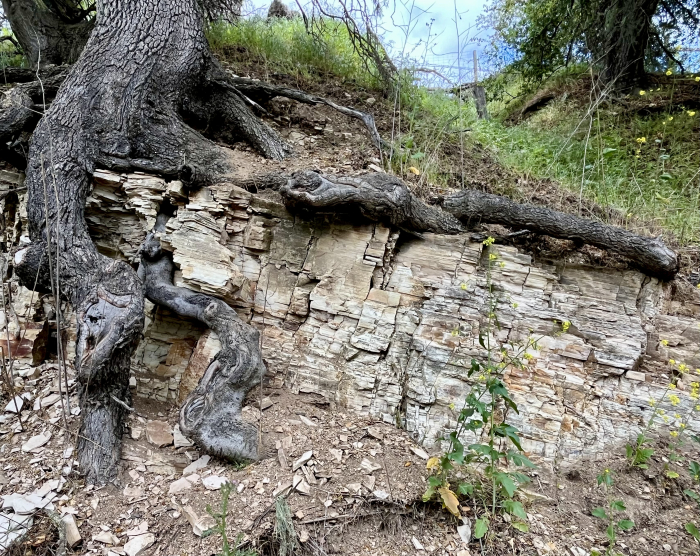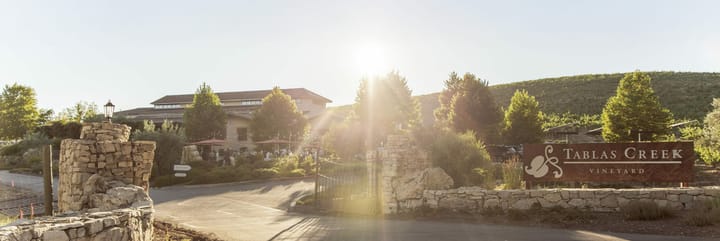A Picture Worth 1,000 Words, Limestone Edition
Every now and then I stumble upon a photograph that illustrates something essential about the place we live and farm. I had that experience over the weekend. It was on a run not far from my house in the Templeton Gap. Running up a hill where the road builders had needed to carve into the hillside, I found this scene of layers of limestone, with the roots of one of our live oak trees clinging on in a way that seems precarious but will probably hold for centuries:

The photo illustrates several of the things that we prize about the soils here. I won't go into it in the detail that I did in my 2020 blog Why Calcareous Soils Matter for Vineyards and Wine Grapes (to which I refer you if you want the full chemical and physical analysis) but I did want to highlight the benefits of these soils. The principal ones include:
- A perfect balance between water retention and drainage. These soils are porous, which allows them to hold the rain we get in the winter and give it back to the vines (and other perennial plants, like the oak trees after which Paso Robles is named) as they need it during the hot, dry summer months. That porosity also means we don't ever get standing water around the roots in our vineyard, and that the underground water sources recharge rapidly after a rainy winter.
- More freshness in our wines. The soils are old (well, not that old, geologically speaking, at 10 million years old) seabed and therefore made almost entirely of calcium carbonate. Those calcium ions attach to the same receptors in grapevine roots that are used for potassium uptake, and potassium is a critical nutrient used by grapevines to break down acidity during the ripening cycle. Displace potassium with calcium, as happens in our soils, and your grapevines preserve acidity later in the growing cycle. Voila: wines with more freshness.
- Deeper root system development. You can see in the above photo the cracks between the rock layers as well as the oak roots' capacity to force their way through. These rocks are relatively soft, soft enough to allow deep penetration of our grapevine roots. We've done soil pits and found roots 15 feet down. We do what we can by restricting or eliminating irrigation to encourage this deeper root growth, which we feel both protects the vines from the often-stressful climate at the surface and ensures that they're pulling maximum character of place out of our vineyard.
- Saline, mineral flavors. I'll start by admitting that this is controversial. There is no direct mechanism by which flavors of soil are transmitted to fruit and therefore wine, so a wine planted in slate-rich soils isn't going to taste like slate itself. But at the same time, grapevines planted in the same climate but different soils absolutely end up making differentiable wines. That's central to the whole French concept of terroir. And for each mechanism that we know -- like the displacement of potassium for calcium and the resulting higher acids at harvest I mentioned above -- there are likely others that we haven't yet identified. Whatever causes it, when you taste through a lineup of Tablas Creek wines, there's a signature of place that I often sense as a saline minerality.
When my dad and the Perrin brothers were looking for a place to found the winery that would become Tablas Creek, high-calcium soils were one of three main criteria they were looking to satisfy (the others were a warm, sunny climate with cool nights and enough rainfall to dry-farm). We wanted these soils because of their similarity to those of Chateauneuf-du-Pape's, though they look very different at the surface because of the overlay of galets, or rounded river stones, that were deposited there by the Rhone during the Ice Ages. As we realized that soils like these are rare in California, it focused our search on the crescent of land in the Central Coast where they can be found, roughly west of a line between the Santa Cruz Mountains to the north and Lompoc to the south. It is those soils that remain a major draw for wineries to west Paso Robles.
How did we find these soils? My dad and the Perrins decided that the most efficient way to do so was to look at road cuts, where CalTrans had done the hard work of digging into the stratigraphy. It was on a drive along Peachy Canyon Road one afternoon in 1989 that they finally found what they'd been searching for for nearly four years. I'd heard the story dozens of times, and in 2021 I found the exact spot and recorded an explainer there:
Join Jason for a 2-minute tour at a spot of historical significance for Tablas Creek. In 1989, at this bend on Peachy Canyon Road, Robert Haas and the Perrin brothers found a crumbling limestone cliff and realized that Paso Robles was the right home for their yet-unnamed project. pic.twitter.com/vmi1BPLIp4
— Tablas Creek (@TablasCreek) November 26, 2021
https://platform.twitter.com/widgets.js
So, when you see the white, fractured rocks that define the geology here, you'll know why vineyards and wineries so often follow.

